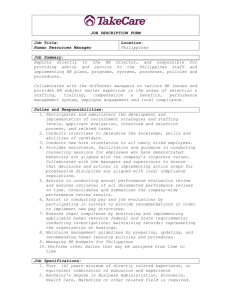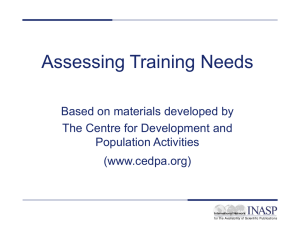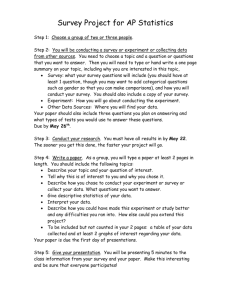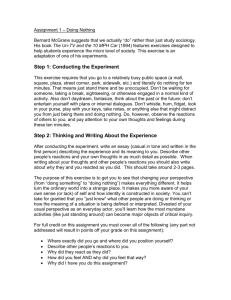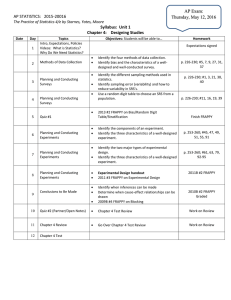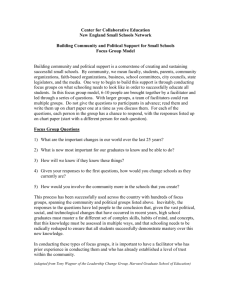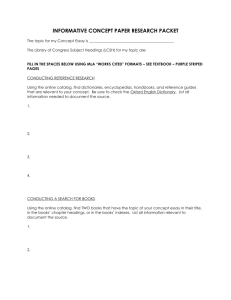chapter tw0
advertisement
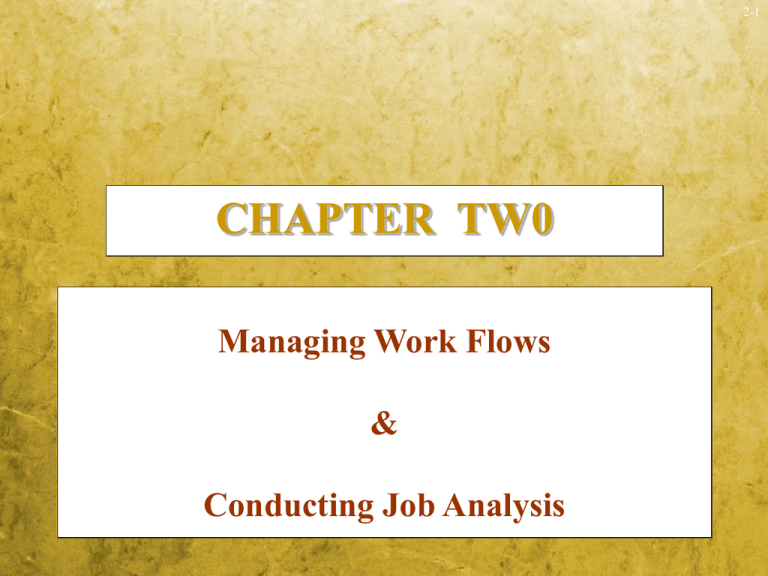
2-1 CHAPTER TW0 Managing Work Flows & Conducting Job Analysis 2-2 Chapter Objectives Review Work from the Following Perspectives: Organizational Group Individual Understand the Significance of Job Analysis in the Workplace Review the Basic Elements of a Job Description Examine some of the current elements involved with creating a ‘flexible’ workforce Review Key Terms Boundaryless Organization Bureaucratic Organization Business Process Reengineering Flat Organization Goal-Setting Theory Human Resource Information Systems Job Analysis Job Characteristics Theory Organizational Structure Two-Factor Theory Work Adjustment Theory Work flow 2-3 Work: Organization Structure Organizational structure: refers to the formal or informal relationship between people in an organization. Work Flow: the way work is organized to meet the organization’s production or service goals To establish their long term goals companies analyze environmental opportunities and threats and conduct a realistic appraisal of how the business can deploy its assets to compete most effectively – this includes its human assets. When companies change their business strategies they should also change their HR strategies – Defender vs. Prospector 2-4 Work: Organizational Structures Bureaucratic Organization: consist of hierarchies with many levels of management and are driven by a top-down, or command and control approach in which managers provide considerable direction and have considerable control over others. Flat Organization: have only a few levels of managers and emphasize a decentralized approach to management which encourages high employee involvement in business decisions. Boundaryless Organization: enable organizations to form relationships (joint ventures, intellectual property, marketing distribution channels, or financial resources) with customers, suppliers, and/or competitors. 2-5 Work: The Organizational Perspective Bureaucratic Organization Bureaucratic Organizations are based on: Top-down approach w/many levels of management Hierarchical career paths within one function Functional Division of Labor Work Specialization Employees working independently 2-6 Work: The Organizational Perspective Bureaucratic Organization 2-7 Work: The Organizational Perspective Bureaucratic Organization 2-8 Work: The Organizational Perspective Flat Organization Flat Organization are based on: Rapid respond to customers' needs or changes in the business environment Useful for organizations that are implementing a total quality management (TQM) strategy Strong emphasis on teams Broadly defined jobs Fewer levels of management General job descriptions 2-9 Work: The Organizational Perspective Flat Organization 2-10 Work: The Organizational Perspective Boundaryless organizations Companies often use a boundaryless organizational structure to: Collaborate with customers or suppliers to provide better quality products or services Enter foreign markets that have entry barriers to foreign competitors Need to manage the risk of developing an expensive new technology. Boundaryless organizations share many of the characteristics of flat organizations, with a strong emphasis on teams, which are likely to include employees representing different companies in the joint venture. 2-11 Work: The Organizational Perspective Boundaryless Organizations 2-12 Work Flow Analysis Managers perform work flow analysis in order to examine how work creates or adds value to the ongoing processes in a business. Work flow analysis looks at how work moves from the customer (the demand source) through the organization to the point at which the work leaves the organization as a product or service for the customer (to meet the demand). Work flow analysis often reveals that some steps or jobs can be combined, simplified, or even eliminated. In other cases, it results in the reorganization of work so that teams rather than individual workers are the source of value creation. 2-13 Work Flow Analysis 2-14 Work Flow Analysis Business Process Reengineering Business Process Reengineering (BPR) is different from restructuring in that its focus is not just on eliminating layers of management, but rather a fundamental rethinking and radical redesign of business processes to achieve dramatic improvements in costs, quality, service, and speed. Uses work flow analysis to identify a company’s core processes involved in producing its product or delivering its service to the customer. Then the company organizing its human resources around those core processes to improve organizational performance. Through this analysis, jobs are identified that can be eliminated or recombined to improve company performance. 2-15 Work Flow Analysis Business Process Reengineering Proponents Allows for reinventing a company by making it ‘lean and mean’ Critics Hammer of ‘Champy and Hammer’ actually says "don't automate; obliterate." To many critics, reengineering’s greatest weakness is its lack of a human side, or its depersonalization. 2-16 Work: The Group Perspective Self-Managed Teams: responsible for producing an entire product, a component, or an ongoing service - often, these teams are trained in technical, administrative, and interpersonal skills. Members are cross-trained on the different tasks assigned to the team. Problem-Solving Teams: do not affect an organization's structure because they exist for only a limited period. They are often used when organizations decide to pursue a TQM effort by making improvements in the quality of a product or service. 2-17 Work: The Group Perspective Special-Purpose Teams: consist of members who span functional or organizational boundaries and whose purpose is to examine complex issues such as introducing new technology, improving the quality of work process, or encouraging cooperation between labor and management in a unionized setting. Virtual Teams: uses interactive computer technologies such as the internet to work together despite being separated by physical distance. Virtual teams allow organizations to position individuals who might not be otherwise available to teams. 2-18 Work: The Individual Perspective Motivation Theories Motivation: that which energizes and sustains human behavior Work Adjustment Theory: which says that motivation and job satisfaction depend on the fit between the employee's abilities or needs and the job and organizational characteristics Two-Factor Theory: which lists the factors that are satisfying and dissatisfying (motivators & maintenance). Two basic premises: Jobs should be designed to provide as many motivators as possible In the long run hygiene factors alone just are not enough 2-19 Work: The Individual Perspective Motivation Theories - Two-Factor Theory Motivators The work Achievement Recognition Responsibility Opportunities for advancement Maintenance (Hygiene) Company policies Working Condition Job security Salary Employee benefits Relationships 2-20 Work: The Individual Perspective Motivation Theories Goal-Setting Theory: which suggests that employees' goals explain motivation and performance Job Characteristics Theory: which states that employee motivation depends on job characteristics such as skill variety, task identity, task significance, autonomy, and feedback 2-21 Work: The Individual Perspective Motivation Theories - Job Characteristics Theory 2-22 Designing Jobs & Conducting Job Analysis Job Design: the process of organizing work into tasks required to perform a specific job All theories of employee motivation suggest that jobs can be designed to increase motivation and performance. Three important influences on job design: work flow analysis; the strategy of the business and the organizational structure that best fits that strategy. 2-23 Designing Jobs & Conducting Job Analysis Job Design Approaches: Work Simplification (versus work elimination) Job Enlargement & Job Rotation Can reduce fatigue and boredom Expands job duties Limited in that it focuses on only one aspect of job motivation Job Enrichment Simple, repetitive task that maximize efficiency Assigns most of the thinking to managers & supervisors Can lead to high degrees of specialization that is not value added and can not readily adapt to a changing environment More opportunities for job autonomy and feedback Limited by technology and employee capabilities Team-Based Job Design Focused on team rather than individual Cross training used w/Flat & Boundaryless organizational structures 2-24 Designing Jobs & Conducting Job Analysis A work flow analysis is followed by a job design and the communication of job expectations to job incumbents. Job Analysis: systematic data gathering and information organization with respect to a job. It identifies the tasks, duties and responsibilities of a particular job. Job analysis is useful for recruitment, selection, performance appraisal, compensation, training, and career development activities. 2-25 Conducting Job Analysis Job Analysis –what it is: It is a systematic method for gathering information It focuses on work behaviors, tasks, and outcomes It identifies the personal qualifications necessary to perform the job and the conditions under which work is performed It reports the job as it exists at the time of analysis; not as it was in the past nor as it exists in another organization 2-26 Conducting Job Analysis Job Analysis –what it is not: It is not an analysis of thought processes, attitudes, traits, or aptitudes It is not a time and motion study It is not an analysis of an individual position 2-27 Conducting Job Analysis Methods for Gathering Job Information Conducting Job Analysis: the people who participate in job analysis should include, at a minimum, the employee and the employee’s immediate supervisor. Questionnaires: the job analyst administers a structured questionnaire to employees who identify the tasks they perform in accomplishing the job. Observation: the job analyst usually inspects the work being performed and records his or her observations. Interviews: interviewing both the employee and the supervisor. Employee recording: gathered by having the employees describe their daily work activities in a diary or log. Combination of methods: likely, no one job analysis method will be used exclusively. A combination is often more appropriate. 2-28 Conducting Job Analysis Reasons for Gathering Job Information Staffing (recruitment and selection) – outlines tasks, duties and responsibilities – allowing the recruiter to know key qualifications need to perform the job. Training and development - if the specification suggests that the job requires a particular knowledge, skill, or ability, and the person filling the position does not possess all the qualifications required, training and/or development is probably in order. Compensation and benefits - the relative value of a particular job to the company must be known before a dollar value can be placed on it. From an internal perspective the more significant its duties and responsibilities, the more the job is worth. Safety and health - information derived from job analysis is also valuable in identifying safety and health considerations. Legal considerations - having properly accomplished a job analysis is particularly important for supporting the legality of employment practices. 2-29 Conducting Job Analysis Reasons for Gathering Job Information Legislation requiring thorough job analysis includes the following acts: Fair Labor Standards Act - employees are categorized as exempt or nonexempt, and job analysis is basic to this determination. Equal Pay Act - if jobs are not substantially different, similar pay must be provided. When pay differences exist, job descriptions can be used to show whether jobs are substantially equal in terms of skill, effort, responsibility, or working conditions. Civil Rights Act - job descriptions may provide the basis for adequate defenses against unfair discrimination charges in initial selection, promotion, and all other areas of human resource administration. Occupational Safety and Health Act - job descriptions are required to specify elements of the job that endanger health or are considered unsatisfactory or distasteful by the majority of the population. Americans with Disabilities Act - employers are required to make reasonable accommodations for workers with disabilities. 2-30 Designing Jobs & Conducting Job Analysis - Techniques Task Inventory Analysis: Task analysis is conducted to identify the details of specified tasks, including the required knowledge, skills, abilities, (KSA) and personal characteristics required for successful task performance. Three Steps: Interview Survey Generation of a Task by a KSA matrix Two major benefits: Systematic & tailor-made Weakness: Can have sole reliance on subject matters expert opinions in generating elements 2-31 Designing Jobs & Conducting Job Analysis - Techniques Functional Job Analysis: Uses three systems: Department of Labor System Sidney Fine's Functional Job Analysis Job Information Matrix System. All three systems contain elaborate definitions and examples of each item in the worker functions This method is based on the theory that all job situations call for some involvement on the part of the worker with data, people and things. Positions are analyzed according to these elements. Strengths: most established system of job analysis comprehensive, simple to use and expandable. Weakness: simplicity of some of its scales as well as the rating activity 2-32 Job Descriptions A job description is a portrait of a job. It may be specific (a detailed summary) or general (associated with work flow strategies that emphasize innovation, flexibility, and loose work planning). Regardless, it is a written document that identifies, defines, and describes a job in terms of its duties, responsibilities, working conditions, and specifications. Job descriptions have four key elements: identification information job summary job duties and responsibilities job specifications and minimum qualifications 2-33 The Flexible Workforce Core Workers or Contingent Workers Core Workers: those having full-time jobs with an employer Contingent Workers: those having a tentative relationship with an employer – include: Temporary Employees Part-Time Employees Outsourcing/Subcontracting Contract Workers College Interns 2-34 The Flexible Workforce Advantages and Disadvantages of Outsourcing Advantages Provide better-quality people with most current skills Cost savings with economies of scale Disadvantages Could lose control of important activities May result in losing an opportunity to gain knowledge and information helpful to company processes 2-35 The Flexible Workforce Flexible Work Schedules Flexible Core Work Hours time/flextime Compressed Workweeks Telecommuting 2-36 Human Resource Information Systems (HRIS) Human Resource Information Systems: systems used to collect, record, store, analyze, and retrieve data concerning an organization's human resources. HRIS Applications: hardware and software applications that work together to help managers make HR decisions – include: employee information applicant tracking hiring procedures goal setting systems skills inventory Payroll benefits administration. HRIS Security and Privacy The HR department must develop policies and guidelines to protect the integrity and security of the HRIS so that private employee information does not fall into the wrong hands.

